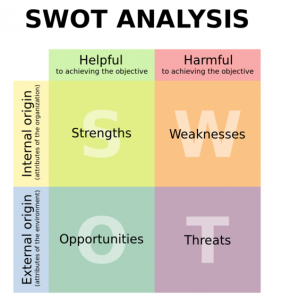Concluding my series on strategic thinking with a look at the planning tools used by many businesses and learned by every A Level Business student in the country and why they are sometimes useless!
Planning tools are not really strategy
Part of objective setting is taking a look at where you are right now as a business and there are various planning tools to do this. The idea is – look at where you are now – analyse it – plan to do better – “simples” as a famous Meer cat would say!
So let’s start with the tried and tested SWOT analysis.

SWOT analysis as strategy
Let’s look at the negatives first with a strategic hat on
Clearly if a company has weaknesses it should seek to improve on them – but what if the weaknesses are at the core of the business? A strategic thinker might label them as either, Worries or Wipe Outs. A worry is something you can handle, but a wipe out is a red flag. Simply knowing your weaknesses is not strategy; strategy is the action you take, so if your product stinks you need to dump it. If you have a problem with staff retention you can work on it by involving employees in your strategy for improving the company.
Sometimes business’s perceived strengths can create weakness.
Let me give you a modern example of a strength becoming a weakness. Apple is famous for innovation and one of their strengths is reduction – making things smaller, less fussy, more intuitive. Their iPod shuffle is a great way to listen to music, until they brought out the Version 3. In this one – instead of your usual controls for Fast forward, Reverse etc. they gave you one single button which you had to double click, or double click and hold, or triple click within 6 seconds – disaster! Reduction gone mad – users hated it, Apple dumped it and went back to the old controls with the next version.
What about threats from outside how do you formulate a strategy to deal with them? A classic threat many companies face is price reduction; famous for example in creating “Supermarket wars”. The knee jerk reaction to competitive price reduction is to follow suit and reduce prices. The assumption is the threat is cheaper pricing. The strategy here may be NOT to reduce prices but to ADD value. Consumers will pay more for perceived value. The ACTUAL threat is how your customers perceive the value of your product.
Strategy for making the most of the positives
A company often misdiagnoses its strengths and misses its opportunities. This happen when the SWOT analysis is too introverted. A strategic approach would involve others outside the company, especially their customers. It would also be aware of changing tastes among its target audience.
Think of that iconic British car, the Mini made uber famous in the fabulous film The Italian Job in 1969 and then enjoyed massively revived interest with the remake in 2003. There is a great line in the movie where they are trying to get the minis into the bus – “get the wheels in line with it…then slam your brakes on or we’ll be in the cabin” – not a bad description of strategy. In other words – don’t over rev the engine of your strategy or strengths.
Mini made a significant change in strategy for an international audience,
As previously it was an affordable iconic British car, now it has become a cool luxury car dominantly for a young segment
Overall, Mini’s marketing strategy is considered to be innovative, creative, and sometimes ‘silly’, which is of great value for its young energetic target audience.
http://www.degruyter.com/view/j/cris.2013.2013.issue-1/cris-2013-0005/cris-2013-0005.xml

This significant switch was based upon a different perception of the Mini’s strength as a product – it was a strategic approach.
PEST as a strategy
PEST analysis (political, economical, social, technological) assesses a market, including competitors, from the standpoint of a particular proposition or a business. It is more of a strategic tool as it forces a company to look outside of itself at the market it operates in and is influenced by. However, some of the factors are often outside of a company’s control so the strategy here is to identify what you actually CAN influence and focus on that. If you cannot influence a factor then your strategy is to learn how to respond and manage the impact…but some of these changes can be foreseen (such as taxation changes) and planned for.
Business models are tools – strategy is more of a company mind set. Thinking strategically requires both big picture awareness and small detail management. So, next time you are brainstorming for SWOT and PEST remember – innovation and strategic thinking are not to be found in boxes.

